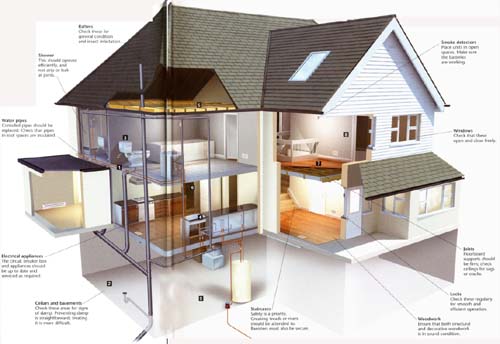Many parts of your home’s interior can be affected by the exterior problems described here. For example, a damp area on the inside can be a result of exterior issues that need addressing. When carrying out an interior inspection, always bear this in mind. Many other interior problems relate to aesthetics and safety. The photographs below highlight some of the issues. Poor paintwork won’t affect the structure of your house, but it will certainly detract from its look. Other issues, such as leaking faucets, require more urgent attention.
Click here or image below for full size and much more detailed information about optimum performance of home interiors:
What to do Next?
Since you can't physically do everything at once, prioritize the most important tasks. Tackle problems related to safety first. For example, ensure that all smoke detectors function correctly. Be certain that you have regular servicing schedules for items such as boilers and any other gas- or oil-fired appliances. Aside from these more obvious items, appliances such as water softeners also require regular checking and in many cases periodic servicing. Also, if you have air-conditioning systems, be sure to check the manufacturer’s recommendations on servicing. Remember that many problems will require professional help, particularly those involving gas. With all such items, servicing may not only ensure safe operation, they may also avoid costly breakdowns and repairs or replacement. Make schedules and budgets for improvements to decoration and /or permanent appliances and make sure you follow through on them. Also consider whether the improvements you make would be appreciated by anyone buying your property.
House File
It is a good idea to keep a record of checks, important phone numbers, service schedules, and general information about your home and its appliances, but organization is key. One good way to keep track is to have a house file where all such information is kept. People often buy notebooks with a plan to transfer all the important details into them, but a ring binder is an easier alternative since scraps of paper, schedules, and instructions can simply be clipped into place. At the very least, keep a drawer in your home that's the sole place for accumulating household maintenance, repair, and improvement information.
Also see: Structural Problems: things to know before the building inspector or home appraiser comes
